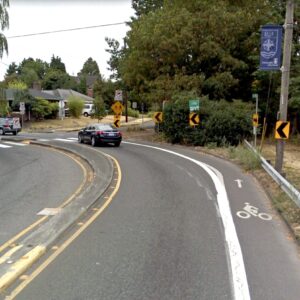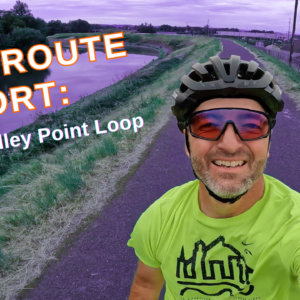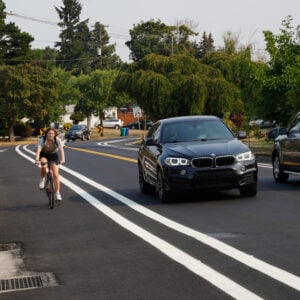The much-anticipated North Willamette Boulevard Active Transportation Corridor project won’t be finished until 2026. While it’s a buzzkill to wait a few more years for three new miles of physically-protected bike lane between North Rosa Parks Way and Richmond Ave, we don’t have to wait much longer to realize many of its benefits.
The reason for the long timeframe between public outreach (summer 2021) and completion (2026) of this project is because it was mostly funded ($4.5 of its $6.1 million price tag) from federal grants. All that US DOT red tape takes a long time to cut through. But the Portland Bureau of Transportation (PBOT) often tries advance projects like this as quickly as possible, and in this case their opportunism means we’ll actually be riding on new, safer bike lanes before the end of this year!
PBOT says they’ll take advantage of a repaving project slated for this spring on Willamette from Portsmouth (at the Chiles Center) to N Carey (entrance to Peninsula Crossing Trail at “the cut”) to re-stripe the road in the way that mimics the dimensions for the 2025 project. In other words, instead of the narrow, door-zone bike lane we have now, they’ll replace the striping with a 10-foot wide bike lane (seven-feet and a three-foot buffer) and two, 10-foot wide general lanes. Doing this now means they won’t have to grind off paint and damage the new pavement later on.
And PBOT will also add the wider bike lanes to another important section of Willamette: between Alma (where the bike lanes currently end) and Richmond (the northern terminus of the project in St. Johns). The city’s rationale for doing this as a “quick build” in advance of the larger project is because, “this missing piece of the bike network was identified as a strong community desire during the North Portland in Motion planning process.”
In both cases, PBOT will return in 2025-2026 and add concrete traffic separators in the bike lane buffer zones.
And in case you hadn’t figured it out yet, this means lanes of on-street car parking on both sides of a 1.4 mile stretch of Willamette Blvd will be removed to make room for the wider bike lanes.
When all is said and done, on-street parking will be removed from the entire project area (except for a one-block cut-out near University of Portland student housing north of Portsmouth). Before you start to worry about neighborhood opposition to this large-scale ban on on-street parking, consider that PBOT has already completed a parking occupancy study (see above). “The parking study indicates that the number of cars currently parking along Willamette Blvd can be easily accommodated on the side streets on the adjacent blocks,” reads a study summary. “In other words, there is substantial spare on-street parking capacity on the closest streets to Willamette Blvd. This means most residents on Willamette Blvd will only need to park roughly one block further away than they are accustomed to currently.”
How’s that for excellent news to start off the new year? Stay tuned for an updated schedule on when we can expect these first two pieces of new bike lane striping to be installed and check the PBOT project website for more information.









Thanks for reading.
BikePortland has served this community with independent community journalism since 2005. We rely on subscriptions from readers like you to survive. Your financial support is vital in keeping this valuable resource alive and well.
Please subscribe today to strengthen and expand our work.
Hurrah! The best news I’ve heard all day. Glad PBOT is prioritizing getting paint on that North section and not waiting till 2026. I’ve been passed so close on this corridor for years and the pedestrian crossings are very lacking too.
Wow! That’s great news. I served as a rep for the Kenton neighborhood on the ‘NoPo in Mo’ project advisory group and of course, safety improvements along the Willamette corridor were a major priority for us.
Grateful to PBOT staff for having found a way to accelerate the implementation of a project that was very important to our community. Woot woot!
If people can find a way to drive on the Glenn Jackson Bridge bike path — and multiple people have done so — they will find a way to drive on these bike lanes thinking they are another lane for cars, and some will use them as passing lanes. Biker beware!
Good point! PBOT needs to make sure cars CANNOT drive in these lanes.
While I truly hope this project works well, let’s not brush off the impact on residents. Walking a block with a bag of groceries and then going back for the second bag is somewhat inconvenient. Thanks are due to residents that will now have to cross the street with toddlers.
Nearly all of these properties have driveways.
This is what really happens: People want parking not just for themselves but also for their guests. Sometimes they have fully functional garages, but they fill them up with stuff and park on the street instead.
I mean it’s not really that difficult to get a trolley dolly for groceries and store it in your car.
At the end of the day people just want to have multiple cars, parked around their house plus always have parking for guests that doesn’t include walking at all. The end result is that cities are mostly car parking and car roads, instead of making room for housing. With the billions spent on maintaining and building new car infrastructure, all houseless people could be off the street and housed.
Imagine if the city and state government were as willing to spend whatever it takes to solve homelessness as they are to expand I-5 with more car lanes.
There is also some need for parking for deliveries. But I’m sure Amazon drivers and UPS won’t block the bike lane.
People already cross the street with toddlers. Now they’ll have more crosswalks in which to do so.
My wish for 2024 is for JM to move to SW Portland so we can start getting bike infrastructure improvements over here. 😉
Contact the top dog Jon with Multnomah County: jon.p.henrichsen@multco.us
This is great news for safely riding on all of Willamette! The popular Cathedral Coffee might need to readress the parking lot layout and entrances and provide an arrive-by-non-car discount